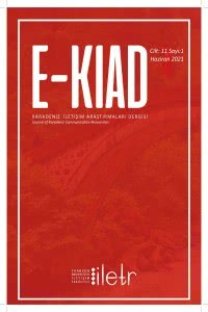SİYASAL REKLAMLARDA DUYGUSAL ÇEKİCİLİK KULLANIMI: 7 HAZİRAN 2015 GENEL SEÇİMLERİNDE SİYASAL PARTİLER TARAFINDAN ÜRETİLEN REKLAM FİLMLERİNİN ANALİZİ
Siyasal reklam, çekicilik, rasyonel çekicilik, duygusal çekicilik
THE USE OF EMOTIONAL APPEALS IN POLITICAL ADS: THE ANALYSIS OF ADVERTISING FILMS PRODUCED BY POLITICAL PARTIES IN 7TH JUNE 2015 GENERAL ELECTIONS
Political advertising, appeal, rational appeal, emotional appeal,
___
- Balcı, Ş. (2007). Negatif siyasal reklamlarda ikna edici mesaj stratejisi olarak korku çekiciliği kullanımı. Selçuk Üniversitesi Sosyal Bilimler Enstitüsü Dergisi, 17, 73-106.
- Belch, G. E. ve Belch, M. A. (2004). Advertising and promotion: an integrated marketing communications perspective. (7. Baskı). Newyork: McGraw-Hill.
- Brader, T.(2005). Striking a responsive chord: how political ads motivate and persuade voters by appealing to emotions. American Journal of Political Science, 49 (2), 388-405.
- Brader, T. (2006). Campaigning for hearts and minds. Chicago: The University of Chicago Press.
- Chuang, P. (2000). The creative strategy approach in political spot advertising: a crosscultural comprasion of the 1996 presidential campaign in taiwan and u.s. Yayınlanmamış Doktora Tezi. Michigan: Wayne State University.
- Elden, M. ve Bakır, U.(2010). Reklam çekicilikleri: cinsellik, mizah, korku. İstanbul: İletişim Yayınları.
- Gray, J.A. (1987). The psychology of fear and stress. (2. Baskı). Newyork: Cambridge University Press.
- Hetsroni, A. (2000). The relationship between values and appeals in israeli advertising: a smallest space analysis. Journal of Advertising, 29 (3), 55-68.
- Kalender, A. (2005). Siyasal iletişim. Konya: Çizgi Kitabevi Yayınları.
- Kern, M. (1989). 30-Second politics: political advertising in the eighties. Newyork: Praeger.
- Lazarus, R. S. (1991). Emotion and adaptation. Newyork: Oxford University Press.
- Marcus, G. E., Neuman, W. R. ve MacKuen, M. (2000). Affective intelligence and political judgment. Chicago: University of Chicago Press.
- Marmor-Lavie, G. ve Weimann, G. (2005). Measuring emotional appeals in israeli election campaigns. International Journal of Public Opinion Research, 18 (3), 318-339.
- Neuman, W. L. (2006). Toplumsal araştırma yöntemleri: nitel ve nicel yaklaşımlar. (Çev: S. Özge). İstanbul: Yayın Odası.
- Panksepp, J. (1998). Affective neuroscience: the foundations of human and animal emotions. Newyork: Oxford University Press.
- Ridout, T. N. ve Searles, K. (2011). It’s my campaign i’ll cray if i want to: how and when campaigns use emotional appeals. Political Psychology, 32 (3), 439-458.
- Shen, F. (2012). Informational/transformational appeals in political advertising: an analysis of the advertising strategies of 2010 U.S gubernatorial elections. Journal of Nonprofit & Public Sector Marketing. 24, 43-64.
- Smith, C. R. (2009). Rhetoric and human consciousness: a history. (4. Baskı). USA: Waveland Press.
- Tokgöz, O. (2008). Siyasal iletişimi anlamak. İstanbul: İmge Kitabevi Yayınları.
- Yılmaz, R. A. (1999). Duygusal çekicilikli reklamların iletişim etkileri. Yayınlanmamış Doktora Tezi. Eskişehir: Anadolu Üniversitesi Sosyal Bilimler Enstitüsü.
- Valentino, N. A., Brader, T. Groenendyk, E. W. Gregorowicz, K. ve Hutchings, V. L. (2011).
- Election night’s alright for fighting: the role of emotions in political participation. Journal of Politics, 73 (1), 156-70.
- Watson, D., Clark, L.A. and Tellegen, A. (1988). Development and validation of brief measures of positive and negative affect: the panas scales. Journal of Personality and Social Psychology, 54 (6), 1063-1070.
- Weber, C. (2012). Emotion, campaigns and political participation. Political Research Quarterly, 66 (2), 414-428.
- https://www.youtube.com/user/chpgenelmerkez (Erişim Tarihi: 10.06.2015)
- https://www.youtube.com/user/MilliyetciHareketMHP (Erişim Tarihi: 10.06.2015)
- https://www.youtube.com/user/HDPgenelmerkezi (Erişim Tarihi: 10.06.2015)
- https://www.youtube.com/channel/UCjoyxlyBIsI-99qbDGZs_0g (Erişim Tarihi: 10.06.2015)
- ISSN: 2146-3212
- Başlangıç: 2011
- Yayıncı: Karadeniz Teknik Üniversitesi
AŞK-I MEMNU DİZİSİNİN ALIMLANMASI ÜZERİNE BİR ÇALIŞMA
Fatma NİSAN, Habibe AKÇAY BEKİROĞLU
İNTERNET BAĞIMLISI ERİŞKİNLERDE SOSYAL MEDYA OYUNLARI ÜZERİNE VAKA İNCELEMESİ: CANDY CRUSH OYUNU
DEĞER VE SİYASET İLİŞKİSİ: 22 TEMMUZ 2007 SEÇİMİ ÜZERİNE BİR DEĞER ANALİZİ
ERKEK AKIL BATI FELSEFESİNDE ‘ERKEK’ VE ‘KADIN”
KULLANICI TANIKLIĞI VE UZMAN TANIKLIĞI REKLAMLARINA YÖNELİK TUTUMLARIN KARŞILAŞTIRILMASI
TÜRKİYE'DE YÜKSELEN SİYASAL İSLAM'IN POSTMODERN NEDENLERİ
BANA BİR HİKÂYE ANLAT: MARKA İLETİŞİMİNDE HİKÂYELEŞTİRME VE İNTERNET
